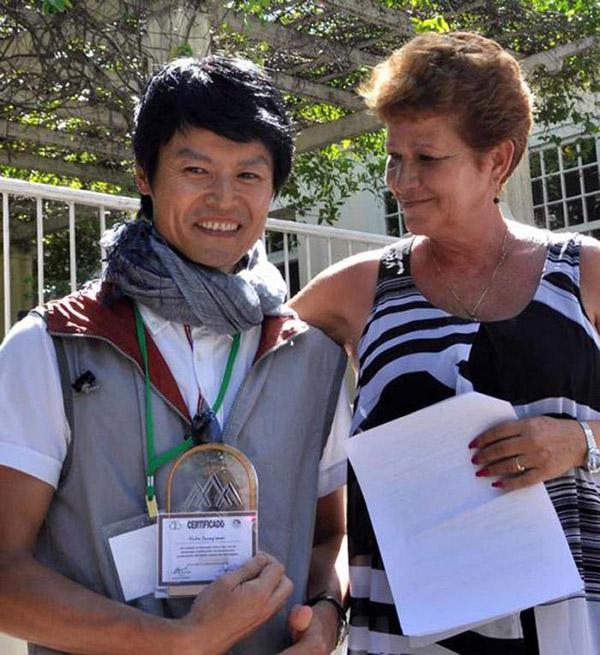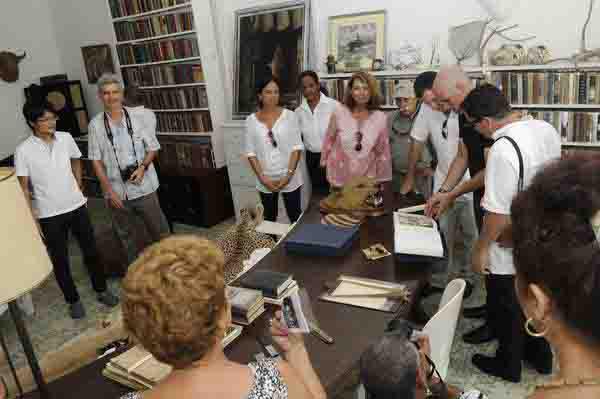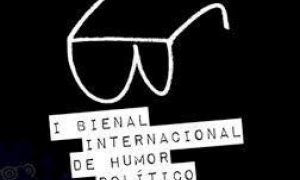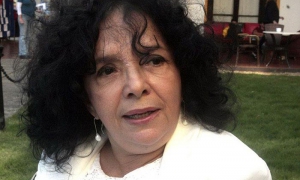
An international colloquium on the life and work of a writer of world stature such as Ernest Hemingway is like putting together a puzzle where you have to carefully select each piece, as all are important to complete the whole picture.
Academics from several universities in the United States and Cuba, Latin American writers who portray the many faces of Hemingway, and a Japanese researcher striving to digitize thousands of his documents, were some of the participants in the fifteenth edition held in Havana, June 18-21.
Granma International interviewed some of these participants, gathered in the Palacio O'Farrill, in Old Havana, who demonstrated the immense value of this colloquium.
Twelve years of joint efforts
Mary Jo Adams is executive director of the Finca Vigia Foundation of Boston and during “the last 12 years I have had the pleasure of working with the Hemingway Museum of San Francisco de Paula. U.S. technical teams have worked with their Cuban colleagues in efforts to preserve the home of Hemingway, liaise regarding his books, documents and photographs, the very rich and vast heritage of Cuba's Hemingway Collection.”
Difficulties?

“It has been a joy as despite the political differences that our countries may have our project has never suffered, it has always had the full support of both governments. For me that has been one of the most important parts of the project. Hemingway is a citizen of the world and I think everyone understands that preserving his cultural legacy here is relevant. We are particularly grateful to the people of Cuba who have allowed us to photocopy Hemingway’s documents, so that academics, researchers and fans can see what he did in Cuba and have an understanding of one of the most important authors in the world.”
What and how many documents will there be?
“Everything that can be preserved, letters, notes. Last April nearly four thousand documents and photographs from the Hemingway Collection were digitized. For example, at the Finca Vigía there are five albums that Hemingway himself and his wife put together. Hemingway always made these albums - since his childhood - which are kept at the John Kennedy Presidential Library and Museum in Boston. The albums in Cuba are unique, invaluable, distinctive. By making photocopies we could see how he organized his thoughts, how he valued what was important to him. One such album is on display at Finca Vigía with documents, photographs, newspaper clippings, story boards of the film versions of his novels. The cultural legacy of Hemingway in Cuba is massive, giant, rich and it is a pleasure to help preserve this collection.”
You were telling me that there is some important news...
“Indeed, the (U.S.) State and Treasury departments approved the purchase and shipment to Cuba of building materials for the Museum. Everything needed for the construction and equipping of a restoration workshop for museum pieces will be brought over, with two laboratories equipped so that nothing has to leave Finca Vigía. The construction works will begin next year.”
The warming of relations
Ada Alfonso, director of the Finca Vigía Museum and president of the Organizing Committee of the Colloquium, expanded on Adams’ thoughts, noting that “this exchange of experiences with the Finca Vigia Foundation has enabled the restoration of correspondence, pages of manuscripts and typed documents, as well as photographs, scrapbooks, cables, books and pamphlets and the storage conditions of thousands of pieces of the collection have also been significantly improved.”
Any further details?
“There are already 3,194 documents digitized and restored that experts and researchers can consult. Among them are treasures such as, in addition to letters, a script of The Old Man and the Sea, on which Hemingway wrote his critiques of some scenes and corrected or expanded dialogues; the epilogue manuscript of For Whom the Bell Tolls, which differs from that published; and codes to decipher the messages he sent from the Pilar yacht in the pursuit of Nazi submarines during World War II.”

There are a larger number of North Americans participating this year...
This edition is characterized by the large presence of U.S. researchers and scholars and the reasons are obvious, the warming of relations between the two countries. It is a fact that over 90% of U.S. citizens who travel to Cuba visit Finca Vigía, where Hemingway lived from 1939 until shortly before his death in 1961.”
Works of fine and decorative art
Michael Connors has taught art history and decorative art at New York University. “It's my passion and expertise, that’s why what exists in Finca Vigía for me is of the utmost importance and I wanted to concentrate on new research on the works of art and especially the furniture.”
The paintings?
“Hemingway collected the most important artists of the early 20th century. Miró, Picasso, Juan Gris, Roberto Domingo, Paul Klee, Georges Braque, Antonio Gattorno. For me it is especially significant that Ada Rosa, and the curators, replaced each painting that Mary took with her when Hemingway died, with exact replicas, so that now, when we walk through the house, it looks exactly as it did 55 years ago.”
What have you discovered regarding the furniture in the house?
“It’s important that the pieces were made by Cuban artisans, with Cuban cedar wood. They form part of Cuban heritage, not only because they belonged to Hemingway, but because Cubans made them.” The Finca Vigía Museum notes that the rustic furniture of the spacious dining room was built by Cuban craftsman Francisco Castro.
Rediscovering Hemingway and Cuba
In a brief interlude at the end of the opening of the Colloquium, Cuban Culture Minister Julián González spoke exclusively to GI, commenting on his certaintythat “given the charm of the figure of Hemingway there are a good deal of not only U.S. researchers but also people from other areas of culture visiting Cuba. They rediscover Hemingway, but they also rediscover the life of our country. The program of the Colloquium is intense and multifaceted, but guests also become familiar with our reality. The level of research that many universities have undertaken on the figure of Hemingway is a luxury. An extraordinary opportunity which will be increasing important to the extent that relations are strengthened and the economic blockade is definitively removed. I think it will be one of the most significant events in our country.”
Hemingway and Cuba?
“What made Hemingway definitively fall in love with our country were the characteristics of our people and their vibrancy. He was an absolute enemy of formalities, rituals, and here he found a suitable setting for his work. Hemingway was a bridge between two cultures then and today perhaps even more so as possible travel opportunities open up for North Americans interested in discovering what Hemingway saw in Cuba and our people that made him establish himself here.”
Hemingway’s letters
Sandra Spanier, professor at Pennsylvania State University, is director and chief editor of the Hemingway Letters Project which brings together the more than six thousand letters by the Nobel prize winner that survive today into 17 volumes, of which three thousand documents belong to the Finca Vigía Museum.
The researcher recalled that the first two volumes were published in 2011 and 2013, bringing together the letters dated between 1907 and 1925, and by the fall of this year the third volume for the period 1926 – 1929 will be ready.
During the Colloquium, Spanier focused on Hemingway's letters to his third wife, journalist Martha Gellhorn, which “cast new light on his relationships and even provide insight into many aspects of the complex personality of the writer.”
A love story?
“Yes of course, but tumultuous. This year marks 75 years since the marriage and what is always remembered is that he dedicated his famous novel For Whom the Bell Tolls to her.”
This story of two strong personalities and writers, both were in Spain during the War of 1936, was brought to the screen in the film Hemingway & Gellhorn, starring Nicole Kidman and Clive Owen.
Finca Vigía, chronicle of the life of Hemingway
Finca Vigía, 15 kilometers from the center of Havana, is located on a hill, where a lookout of the Spanish army was located until well into the nineteenth century. Hence its name.
Martha Gellhorn discovered it in 1939 reading the classifieds in a Havana newspaper and convinced the writer to leave the Hotel Ambos Mundos, where they were staying, and move there. First they rented it and then, in 1940, Hemingway bought the estate for 18,500 pesos.
According to researchers at the Museum, it would be his fourth wife, Mary Welsh, who took to decorating the property making it “a splendid place,” such that Michael Connors decided to investigate its paintings and furniture.
The library has over 9,000 books, magazines and other publications stored on its shelves - 2,000 of them underlined or with notes in the margins by the writer - arranged to his liking: irregularly, without worrying about grouping authors and genres together. The design and furniture of the dining room resembles a Spanish tavern and even the bathroom is cause for investigation, as Hemingway had a habit of weighing himself every day and writing the result on the wall. These annotations, explained Professor Elisa Serrano, were revealed in 2006 and they proceeded to rescue them.
Finca Vigía was Ernest Hemingway’s most permanent residence on the island, and there he was awarded the Nobel Prize in Literature in 1954, which he dedicated and gifted to the Cuban people.
After his suicide in Idaho, in April 1961, Mary Welsh traveled to Cuba to collect his manuscripts and other valuables, including paintings by Miró and Juan Gris, and donated the house with most of its belongings to the Cuban government. The Ernest Hemingway House Museum received the National Award for Restoration in 2007.
Ada Rosa Alfonso announced that the 16th International Ernest Hemingway Colloquium will be held in June 2017, and will be “marked by the celebration of 80 years of To Have and Have Not, 65 of The Old Man and the Sea, which won him the Pulitzer Prize in 1953, and the 55th anniversary of the founding of the Museum.”






